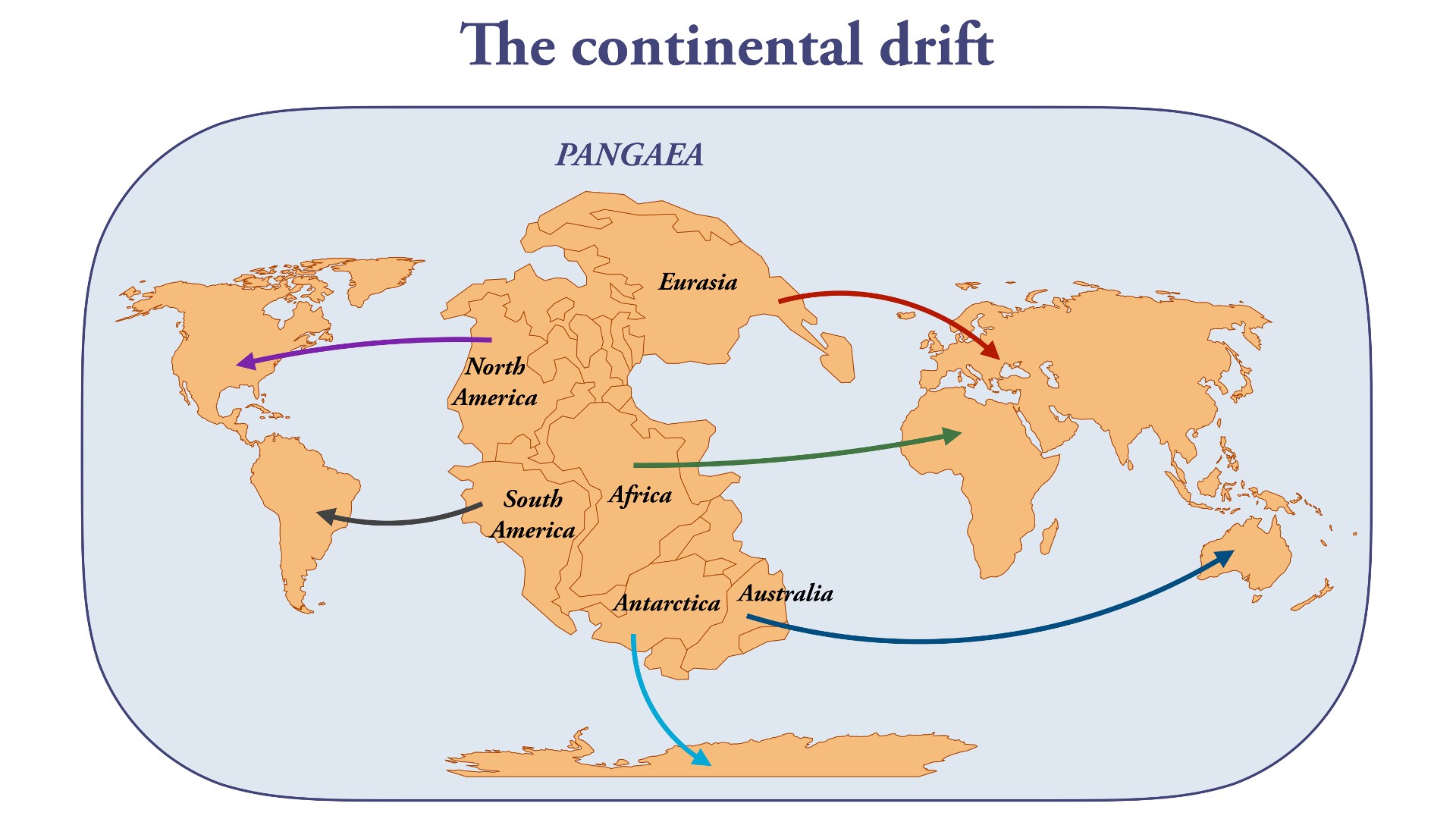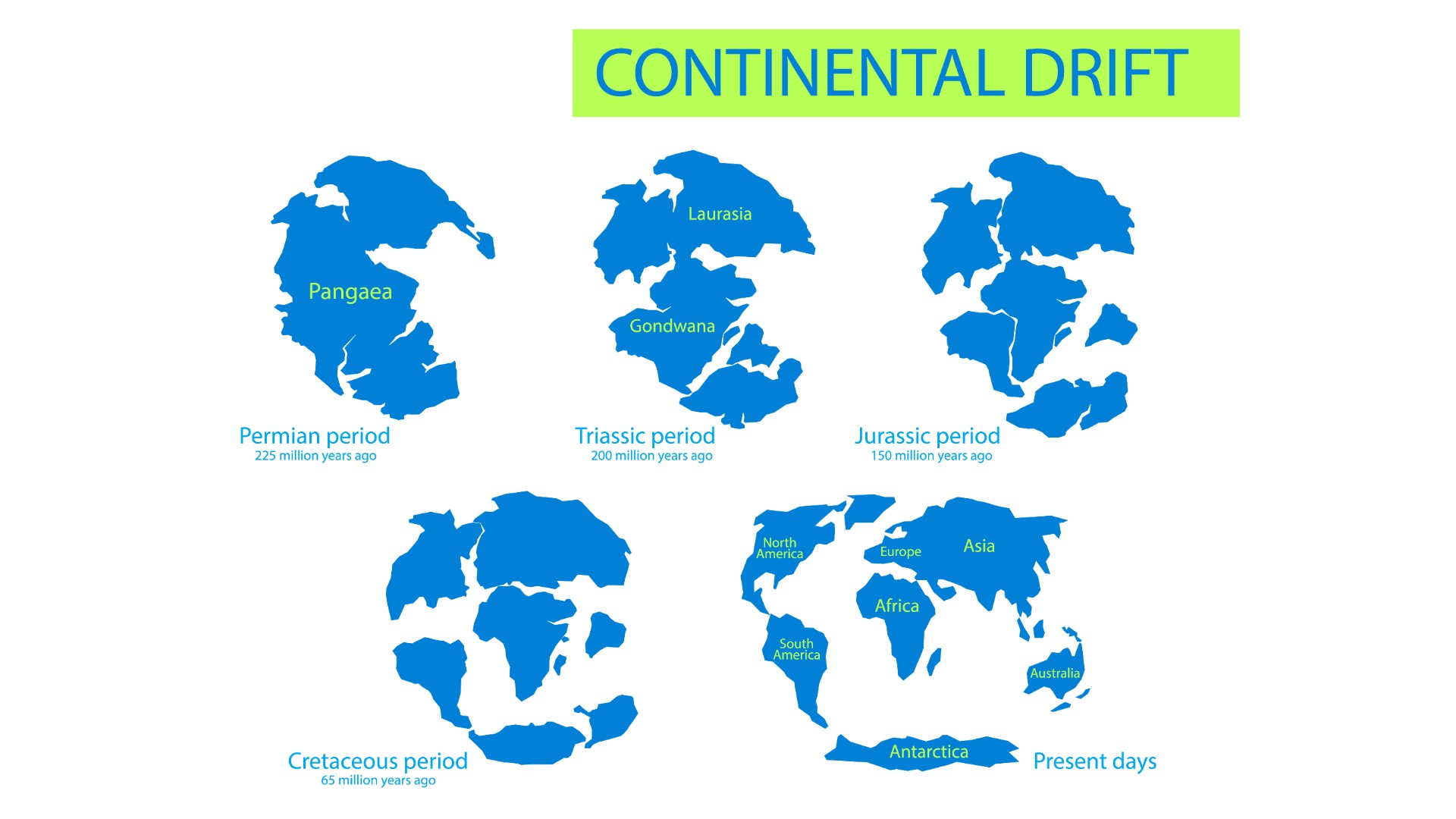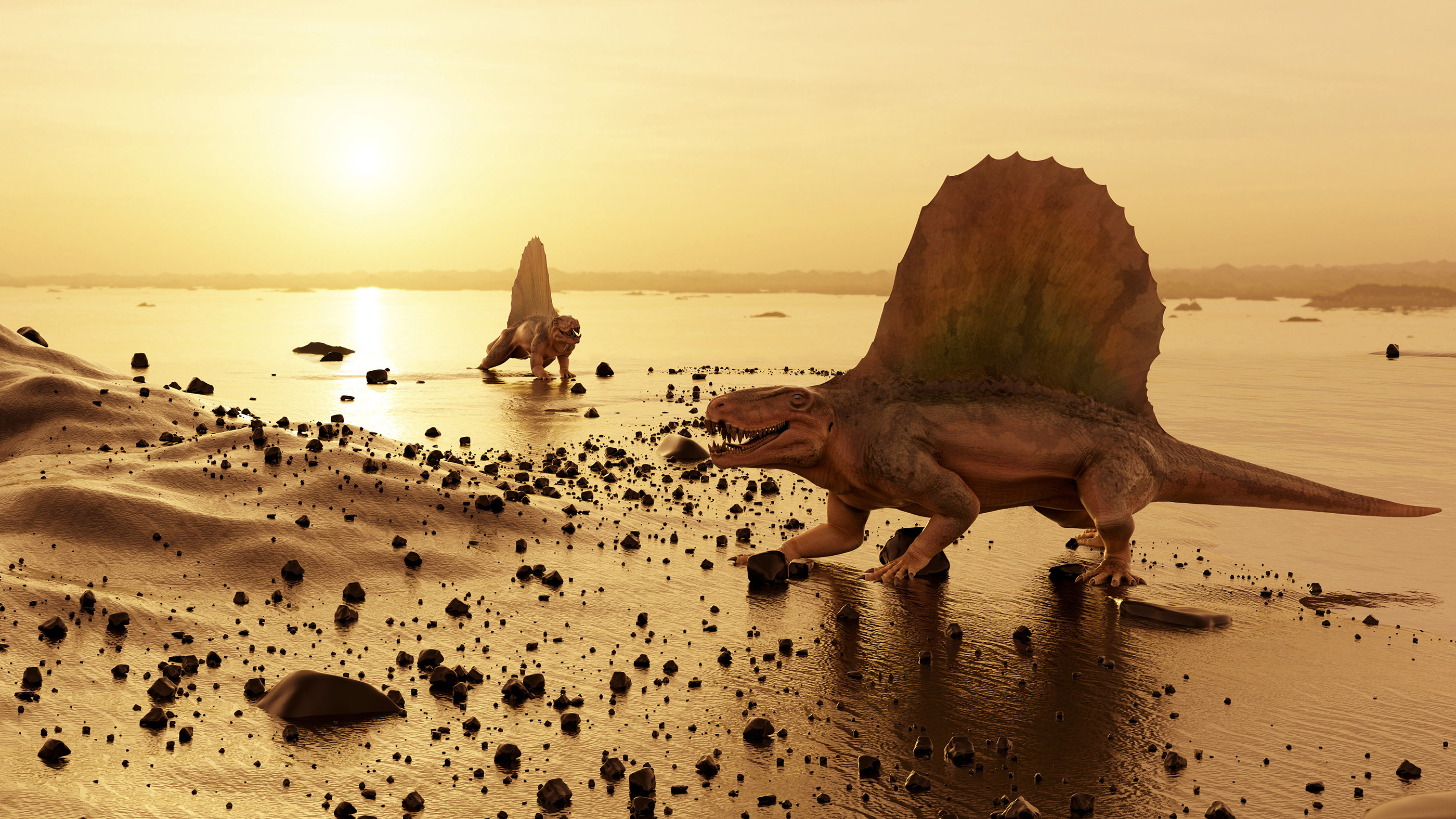What was Pangaea? What caused it to break apart?
Pangaea: Facts well-nigh an aboriginal supercontinent

Near 300 million years ago, Earth didn't have seven continents, simply instead 1 massive supercontinent chosen Pangaea, which was surrounded by a single sea called Panthalassa.
The caption for Pangaea's formation ushered in the modern theory of plate tectonics, which posits that the Globe's outer shell is broken up into several plates that slide over Earth'south rocky shell, the curtain.
Over the form of the planet'southward four.5 billion-year history, several supercontinents have formed and broken up, a result of churning and circulation in the Earth's curtain, which makes up 84% of the planet's volume, co-ordinate to the U.Due south. Geological Survey (opens in new tab). This breakup and formation of supercontinents has dramatically altered the planet's history.
"This is what's driven the entire evolution of the planet through time. This is the major backbeat of the planet," said Brendan Spud, a geology professor at the St. Francis Xavier Academy, in Antigonish, Nova Scotia.
Pangaea's history
More than than a century ago, the scientist Alfred Wegener proposed the notion of an aboriginal supercontinent, which he named Pangaea (sometimes spelled Pangea), after putting together several lines of evidence.
The beginning and nigh obvious was that the "continents fit together like a natural language and groove," something that was quite noticeable on whatever accurate map, Spud said. Another telltale hint that Earth's continents were all ane land mass comes from the geologic record. Coal deposits found in Pennsylvania have a similar composition to those spanning across Poland, Great Britain and Frg from the same time catamenia. That indicates that North America and Europe must have once been a single landmass. And the orientation of magnetic minerals in geologic sediments reveals how Earth's magnetic poles migrated over geologic fourth dimension, Potato said.
In the fossil record, identical plants, such every bit the extinct seed fern Glossopteris, are found on at present widely disparate continents. And mountain bondage that at present prevarication on dissimilar continents, such equally the Appalachians in the The states and the Atlas Mountains spanning Morocco, People's democratic republic of algeria and Tunisia were all part of the Central Pangaea Mountains, formed through the collision of the supercontinents Gondwana and Laurussia.

The word "Pangaea" comes from the Greek "pan," which means "all," and "gaia" or "Earth," according to the Online Etymology Dictionary (opens in new tab). The supercontinent formed through a gradual process spanning a few hundred million years.
In the early Phanerozoic eon (541 meg years ago to now), well-nigh all of the continents were in the Southern Hemisphere, with Gondwana, the largest continent, spanning from the South Pole to the equator, according to a chapter in the scientific book "Ancient Supercontinents and the Paleogeography of Earth (opens in new tab)" (Elsevier, 2021). The Northern Hemisphere was largely covered by the Panthalassic Ocean. Another ocean — called Iapetus, after a mythical Greek titan — betwixt the paleo-continents Laurentia, Baltica and Gondwana, began to close during the Ordovician menstruation (485 million to 444 meg years ago) so disappeared during the Silurian period (444 one thousand thousand to 419 one thousand thousand years ago), when Baltica and Avalonia collided with Laurentia to form Laurussia, co-ordinate to the chapter, "Phanerozoic paleogeography and Pangea (opens in new tab)."
Finally, about 320 million years ago, there was a major collision, geologically speaking, "when Gondwana, Laurussia, and intervening terranes collided to grade the Pangea supercontinent," according to the chapter, written past World scientists Trond Torsvik, Mathew Domeier and Robin Cocks.
Still, Pangaea wasn't the megalithe virtually people think it is. "Pangea never included all the continents at any one time," according to the chapter. For instance, "the Paleotethys Ocean to the eastward of Pangea remained wide throughout the Carboniferous [359 meg to 299 million years ago] and presented something of a bulwark between the supercontinent and a number of large, independent Asian terranes, including Tarim, North Mainland china, S Mainland china, and Annamia."
Later, during the Permian menses (299 million to 251 1000000 years agone), "many former peri-Gondwanan terranes drifted off the north-east Gondwana margin, commencing the opening of the Neotethys Ocean," according to the chapter.
When did Pangaea break apart?

Pangaea broke upward in several phases between 195 million and 170 meg years ago. The breakup began about 195 one thousand thousand years agone in the early Jurassic period, when the Central Atlantic Ocean opened, according to the chapter. The supercontinent fractured largely along previous sutures.
Gondwana (what is now Africa, South America, Antarctica, Bharat and Australia) first split from Laurasia (Eurasia and North America). And then virtually 150 million years ago, Gondwana broke upward. India peeled off from Antarctica, and Africa and South America rifted, according to a 1970 article in the Periodical of Geophysical Enquiry (opens in new tab). Around 60 one thousand thousand years agone, N America split off from Eurasia.
Pangaea's climate
Having one massive landmass made for very different climatic cycles. For instance, the interior of the continent may have been utterly dry, as information technology was locked backside massive mountain bondage that blocked all moisture or rainfall, Murphy said.
Just the coal deposits institute in the U.s.a. and Europe reveal that parts of the ancient supercontinent virtually the equator must have been a lush, tropical rainforest, similar to the Amazonian jungle, Murphy said. (Coal forms when expressionless plants and animals sink into swampy water, where pressure and water transform the material into peat, so coal.)
"The coal deposits are substantially telling us that there was plentiful life on land," Murphy told Alive Science.
Climate models confirm that the continental interior of Pangaea was extremely seasonal, co-ordinate to a 2016 article in the journal Palaeogeography, Palaeoclimatology, Palaeoecology (opens in new tab). The researchers in this study used biological and concrete data from the Moradi Formation, a region of layered paleosols (fossil soils) in northern Niger, to reconstruct the ecosystem and climate during the fourth dimension period when Pangaea existed. Comparable with the modern-solar day African Namib Desert and the Lake Eyre Basin in Australia, the climate was by and large barren with short, recurring wet periods that occasionally included catastrophic wink floods.
The climate as well influenced where animals lived. During the late Triassic, Reptile-like animals in the family Procolophonidae lived in ane region, while mammal relatives, known as cynodonts, lived in another, a 2011 study in the journal Proceedings of the National Academy of Sciences (opens in new tab) constitute. Cynodonts inhabited one tropical expanse of Pangaea, where monsoon-like rains fell twice a year. Upward north, procolophonids lived in temperate regions where it only rained once a year. It's likely that the cynodonts needed a water-rich area, which restricted their movements on Pangaea, the researchers said.
"It'southward interesting that something as basic as how the torso deals with waste can restrict the movement of an entire grouping," Whiteside said in a statement (opens in new tab). In drier areas, "the reptiles had a competitive reward over mammals," which is likely why they stayed at that place, Whiteside said.
Pangaea animals

Pangaea existed for more than 100 1000000 years, and during that fourth dimension many animal groups thrived. During the Permian period, insects such as beetles and dragonflies flourished, as did the predecessors of mammals: the synapsids. Simply the existence of Pangaea overlapped with the worst mass extinction in history, the Permian-Triassic (P-TR) extinction outcome. Also called the Great Dying, it occurred effectually 252 million years ago and caused 96% of all marine species and around 70% of terrestrial species to go extinct, according to the Geological Club of America (opens in new tab).
The early Triassic period saw the rise of archosaurs, a group of animals that somewhen gave rise to crocodiles, birds and a plethora of reptiles, including pterosaurs. And about 230 million years ago some of the earliest dinosaurs emerged on Pangaea, including theropods, largely carnivorous dinosaurs that more often than not had air-filled bones and feathers like to birds.
Cycle in history
The current configuration of continents is unlikely to exist the concluding. Supercontinents have formed several times in Earth'south history, only to be split off into new continents. Right now for example, Commonwealth of australia is inching toward Asia, and the eastern portion of Africa is slowly peeling off from the rest of the continent.
Based on the emergence of other supercontinents in the Precambrian supereon (four.v billion to 541 one thousand thousand years ago), it appears that supercontinents occur periodically every 750 meg years, according to a 2012 report in the journal Gondwana Research (opens in new tab).
Nearly scientists believe that the supercontinent bicycle is largely driven past circulation dynamics in the pall, co-ordinate to a 2010 article in the Journal of Geodynamics (opens in new tab).
Beyond that, the details get fuzzy. While the rut formed in the mantle likely comes from the radioactivity of unstable elements, such every bit uranium, scientists don't agree on whether there are mini-pockets of heat flow within the mantle, or if the unabridged shell is i big heat conveyor chugalug, Murphy said.
Current inquiry on Pangaea
Scientists have created mathematical, 3D simulations to better empathize the mechanisms behind continental movement. In a 2018 article in the journal Geoscience Frontiers (opens in new tab), World scientists Masaki Yoshida and Chiliad. Santosh explained how they produced simulations of large-scale continental movements since the breakup of Pangaea about 200 million years agone. The models show how tectonic plate motion and drapery convection forces worked together to intermission apart and motility large country masses. For example, Pangaea's large mass insulated the drape underneath, causing pall flows that triggered the initial breakup of the supercontinent. Radioactive decay of the upper curtain as well raised the temperature, causing upward drapery flows that broke off the Indian subcontinent and initiated its northern movement.
Yoshida and Santos created additional geological models to predict pall convection and continental movement patterns 250 one thousand thousand years in the futurity. These models suggest that over millions of years, the Pacific Body of water will close every bit Australia, N America, Africa, and Eurasia come together in the Northern Hemisphere. Eventually, these continents volition merge, forming a supercontinent called "Amasia." The 2 remaining continents, Antarctica and Due south America, are predicted to remain relatively immobile and dissever from the new supercontinent.
Additional reporting by Carol Stoll, Live Science contributor
Additional resources
- Enroll in the free online Cousera class "Our Earth: Its Climate, History, and Processes (opens in new tab)" offered by the University of Manchester in the U.K.
- U.S. Geological Survey: This Dynamic Earth: The Story of Plate Tectonics (opens in new tab)
- Check out this interactive map (opens in new tab) that shows where mod countries could have sat on the Pangaea supercontinent.
Bibliography
Live Science. "What is plate tectonics?" May 26, 2021.
U.Due south. Geological Survey. "The Interior of the Globe (opens in new tab)." Last modified Jan. 14, 2011.
Online Etymology Dictionary. "Pangaea (opens in new tab)."
Torsvik, T.H., et al. "Chapter eighteen - Phanerozoic paleogeography and Pangea (opens in new tab). 2021.
Robert S. Dietz,John C. Holden. Journal of Geophysical Research (opens in new tab). 1970.
Looy, C.V. et al. Palaeogeography, Palaeoclimatology, Palaeoecology (opens in new tab). 2016.
Jun Liu and Fernando Abdala. "Early Evolutionary History of the Synapsida (opens in new tab)." Sept. 21, 2013.
Geological Gild of America. "The "Great Dying (opens in new tab)." May xix, 2021.
Whiteside, J.H., et al. Proceedings of the National Academy of Sciences (opens in new tab). 2011.
Brownish University. "On Pangaea, the supercontinent, latitude and rain dictated where species lived (opens in new tab)." May 12, 2011.
Joseph G. Meert. Gondwana Research (opens in new tab). 2012.
M. Santosh. Journal of Geodynamics (opens in new tab). 2010.
Masaki Yoshida and M. Santosh. Geoscience Frontiers (opens in new tab). 2018.
Source: https://www.livescience.com/38218-facts-about-pangaea.html#:~:text=The%20models%20show%20how%20tectonic,initial%20breakup%20of%20the%20supercontinent.
0 Response to "What was Pangaea? What caused it to break apart?"
Post a Comment